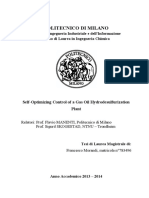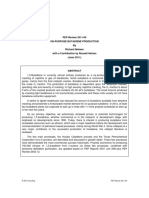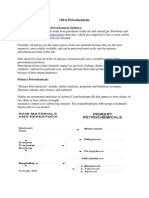C4 Derivatives
C4 Derivatives
Uploaded by
daabgchiCopyright:
Available Formats
C4 Derivatives
C4 Derivatives
Uploaded by
daabgchiOriginal Description:
Copyright
Available Formats
Share this document
Did you find this document useful?
Is this content inappropriate?
Copyright:
Available Formats
C4 Derivatives
C4 Derivatives
Uploaded by
daabgchiCopyright:
Available Formats
Derivatives of C4 Hydrocarbons
raw materials to be considered are butadiene, n-butylenes and isobutylene
butylenes produced from refinery catalytic crackers
butadiene prod. fr. butylenes dehydrogenation
demand for isobutylene : production of butyl rubber and polybutenes
industrial development of C4 prodts dominated by butadiene used in synthetic
rubber industry
Separation of C4 Hydrocarbons
straight fractional distillation will not meet the requirement of separating the C 4
HC components
precise nature of C4 separation differ according to individual requirements
common practice to first remove butadiene present in stream
traditional method of extraction and recovery involves selective absorption of
butadiene in ammoniacal cuprous acetate
achieved in multistage extractor/settler system with the HC stream
flowing countercurrent to the copper ammonium acetate solution
butadiene desorbed fr. the solution by an increase in temp. and
reduction in press & purified by distillation
popular technique by extractive distillation using external
component that affect the relative volatilities of C4 HCs
furfural as external component then changed to
acetonitrile
using acetonitrile, C4 mixt. distilled in presence of
aqueous solvent, butadiene dissolves preferentially and butadiene/solvent
mixt. Withdrawn fr. bottom of column
2nd column, butadiene separated fr. acetonitrile
3rd column, final purification achieved
* aspect of butadiene recovery is purity of final
prodt. in particular effective removal of traces of acetylenes and unwanted dienes
butadiene free C4 stream treated for isobutylene
removal
in refinery catalytic cracker C4 streams becomes
the 1st operation
achieved by selective absorption in 65%
sulphuric acid @ 10-20oC as absorption medium
isobutylene recovered by diluting acid to
40-50% concentration and heating or to warm fat acid containing absorbed
isobutylene to 80-100oC for a period after which isobutylene polymers abt.
80% of total as diisobutylene, separate out as an upper HC layer
separation of isobutylene fr. nbutylenes usg. the versatile molecular sieve method
molecular sieve prodt.
designed to adsorb n-butylenes and to exclude the isobutylene
n-butylenes are purged fr.
molecular sieve bed by higher boiling material which may be separated fr. nbutylenes by distillation
after butadiene
and isobutylene removal the remaining C4 stream, comprising 3 n-butylene
isomers with n-butane and isobutane does not require further separation
You might also like
- Production of Propylene Oxide BY Hppo TechnologyDocument33 pagesProduction of Propylene Oxide BY Hppo Technologyramya tejaswiniNo ratings yet
- Methanol PresentationDocument29 pagesMethanol Presentationافكر اشتري كورياNo ratings yet
- 50 Olefin ReductionDocument2 pages50 Olefin ReductiondimkuhNo ratings yet
- Introduction MCC Oxo ProcessDocument5 pagesIntroduction MCC Oxo ProcessDeep PatelNo ratings yet
- Exxonmobil FCC TechnologyDocument4 pagesExxonmobil FCC TechnologySubhasish Mitra100% (2)
- Vinyl Chloride Monomer (VCM) Production ProcessDocument11 pagesVinyl Chloride Monomer (VCM) Production ProcessKubra ĖdrisNo ratings yet
- C4-Based Processes 8-01-11Document18 pagesC4-Based Processes 8-01-11Sistine Maquiling Cobcoban100% (1)
- Principles and Applications of Fermentation TechnologyFrom EverandPrinciples and Applications of Fermentation TechnologyArindam KuilaNo ratings yet
- An Overview of Industrial Processes For The Production of Olefins - C4 HydrocarbonsDocument12 pagesAn Overview of Industrial Processes For The Production of Olefins - C4 HydrocarbonsSalman SheikhNo ratings yet
- Methanol SdsDocument9 pagesMethanol SdsLeslieBigbearNo ratings yet
- ResearchDocument32 pagesResearchRitika0% (1)
- SolventExtraction OfAromaticComponents FromLube-OilCut ByN-methylpyrrolidoneDocument8 pagesSolventExtraction OfAromaticComponents FromLube-OilCut ByN-methylpyrrolidonebelizondohNo ratings yet
- Preliminary Report CompletedDocument28 pagesPreliminary Report CompletedJacky100% (1)
- Hydrogenation of Nitrobenzene: To AnilineDocument7 pagesHydrogenation of Nitrobenzene: To Anilinesuzie annNo ratings yet
- Formic Acid TechnologyDocument3 pagesFormic Acid Technologyatharnadim_osNo ratings yet
- Gas PurificationDocument26 pagesGas PurificationMahmud Rahman BizoyNo ratings yet
- Generic CDU and VDUDocument187 pagesGeneric CDU and VDUHassanSalem100% (2)
- Chapter 2 Process and Material SelectionDocument12 pagesChapter 2 Process and Material SelectionAli AhsanNo ratings yet
- 4244 12672 1 PB PDFDocument15 pages4244 12672 1 PB PDFVinh Do ThanhNo ratings yet
- Self-Optimizing Control of A Gas Oil HydrodesulfurizationDocument167 pagesSelf-Optimizing Control of A Gas Oil Hydrodesulfurizationvu anh ducNo ratings yet
- Best Practices For Aromatics Extractive Distillation in Integrated ComplexesDocument8 pagesBest Practices For Aromatics Extractive Distillation in Integrated ComplexesNaiduJagarapuNo ratings yet
- Decomposition of MtbeDocument4 pagesDecomposition of MtbeEzzati AzizNo ratings yet
- 2.4 Manufacturing Process: Chlorination of MethaneDocument6 pages2.4 Manufacturing Process: Chlorination of MethaneAnonymous XSuXpopx0QNo ratings yet
- Chapter 3Document14 pagesChapter 3Larry Jampong100% (1)
- Production of Methyl Tertiary Butyl Ether Using Snamprogetti ProcessDocument103 pagesProduction of Methyl Tertiary Butyl Ether Using Snamprogetti ProcessMuntazer QasimNo ratings yet
- 08-The Orthoflow WayDocument12 pages08-The Orthoflow WayAbhimanyu SharmaNo ratings yet
- Sample ABCDocument128 pagesSample ABCNaviinthiran Arasu100% (1)
- (Petrochemicals Industries) Lecture 2 and 3Document82 pages(Petrochemicals Industries) Lecture 2 and 3Abdelhai YehiaNo ratings yet
- University of Lagos: Process Description For The Production of Mtbe A Presentation by Group 10 ConsistingDocument7 pagesUniversity of Lagos: Process Description For The Production of Mtbe A Presentation by Group 10 ConsistingJide Williams100% (1)
- Growth of Escherichia Coli in A 5 Litre Batch Fermentation VesselDocument15 pagesGrowth of Escherichia Coli in A 5 Litre Batch Fermentation VesselAs'ad Mughal100% (2)
- Iocl Section 1 - Process SpecficationDocument73 pagesIocl Section 1 - Process SpecficationYogi173No ratings yet
- SINOPEC Methanol-To-Olefins (S-MTO) Technology Process PDFDocument1 pageSINOPEC Methanol-To-Olefins (S-MTO) Technology Process PDFHendriyana StNo ratings yet
- Dehydration of Natural GasDocument9 pagesDehydration of Natural GasHuda ShahNo ratings yet
- Process Control Formaldehyde ProductionDocument3 pagesProcess Control Formaldehyde ProductionM Asrar Sidon0% (1)
- Jose de BarrosDocument33 pagesJose de BarrosTomasz OleckiNo ratings yet
- ButadieneDocument10 pagesButadienearmanNo ratings yet
- CHET 1710 Petroleum Processing Technology Syllabus (PetroRabigh)Document9 pagesCHET 1710 Petroleum Processing Technology Syllabus (PetroRabigh)Rafique Ahmed AbroNo ratings yet
- Research ProjectDocument30 pagesResearch ProjectYasser AshourNo ratings yet
- Training Report of IoclDocument71 pagesTraining Report of IoclAnupam SrivastavNo ratings yet
- Chemical Plant Design and Process EconomicsDocument14 pagesChemical Plant Design and Process Economicsespinosa_mra978No ratings yet
- Faculty of Chemical Engineering (Fche)Document114 pagesFaculty of Chemical Engineering (Fche)Divyansh Singh ChauhanNo ratings yet
- Mthanol ProductionDocument61 pagesMthanol Productionvv vvNo ratings yet
- Uop Unionfining Technology: Peter KokayeffDocument12 pagesUop Unionfining Technology: Peter KokayeffBharavi K SNo ratings yet
- Refinery Configurations - Designs For Heavy Oil - Hydrocarbon Processing - October 2011Document12 pagesRefinery Configurations - Designs For Heavy Oil - Hydrocarbon Processing - October 2011SumitAggarwal100% (1)
- Para-Xylene Production ProcessDocument3 pagesPara-Xylene Production ProcessHashan Eranda100% (2)
- Aromatics PDFDocument24 pagesAromatics PDFGerardo RiosNo ratings yet
- Ammonia ManufacturingDocument16 pagesAmmonia ManufacturingMuhammad Irfan MalikNo ratings yet
- Biodiesel Production Using Nanocatalyst 3Document48 pagesBiodiesel Production Using Nanocatalyst 3ali abdulrahman al-ezziNo ratings yet
- COWIFinalDocument69 pagesCOWIFinalNovia Mia YuhermitaNo ratings yet
- Catalytic Hydrogenation of Organic Polymers by Mixed Transition Metal OxidesDocument8 pagesCatalytic Hydrogenation of Organic Polymers by Mixed Transition Metal OxidesInternational Journal of Innovative Science and Research TechnologyNo ratings yet
- Trainning Report Iocl MathuraDocument19 pagesTrainning Report Iocl MathuraDheeraj ShuklaNo ratings yet
- CHAPTER 3 (v3) - ETHYLENE BASED PRODUCTIONDocument46 pagesCHAPTER 3 (v3) - ETHYLENE BASED PRODUCTIONAleeya KamalNo ratings yet
- Cumene A PDFDocument4 pagesCumene A PDFdanena88No ratings yet
- Axens CCR Reforming Octanizing Technology To Thailand Refinery-EnglishDocument1 pageAxens CCR Reforming Octanizing Technology To Thailand Refinery-EnglishmohanspathakNo ratings yet
- Oil To PetrochemicalsDocument3 pagesOil To PetrochemicalsRaj Sunil KandregulaNo ratings yet
- Crude Oil DistillationDocument15 pagesCrude Oil DistillationAjayMehraNo ratings yet
- Hydroprocessing for Clean Energy: Design, Operation, and OptimizationFrom EverandHydroprocessing for Clean Energy: Design, Operation, and OptimizationNo ratings yet
- C4S and C5SDocument5 pagesC4S and C5SEzekielNo ratings yet
- Industrial ProcessDocument13 pagesIndustrial ProcessdaabgchiNo ratings yet
- Institutional Solid Waste ManagementDocument34 pagesInstitutional Solid Waste ManagementdaabgchiNo ratings yet
- Chapter 4: Palm Oil and Oleochemical Industries.: Presented By: Lovelyna Eva Nur Aniqah Siti MaryamDocument15 pagesChapter 4: Palm Oil and Oleochemical Industries.: Presented By: Lovelyna Eva Nur Aniqah Siti MaryamdaabgchiNo ratings yet
- Waste Management in Wine IndustryDocument23 pagesWaste Management in Wine Industrydaabgchi0% (1)
- MarcetDocument4 pagesMarcetdaabgchiNo ratings yet
- Block Flow Diagram (BFD) Process Flow Diagram (PFD) & Piping and Instrumental DiagramDocument4 pagesBlock Flow Diagram (BFD) Process Flow Diagram (PFD) & Piping and Instrumental DiagramdaabgchiNo ratings yet
- Air Pollution: Produced byDocument10 pagesAir Pollution: Produced bydaabgchi100% (1)
- Topic 3: Bernoulli's Equation Objectives:: Kinetic Potential External Work Internal Heating CoolingDocument2 pagesTopic 3: Bernoulli's Equation Objectives:: Kinetic Potential External Work Internal Heating CoolingdaabgchiNo ratings yet
- Methods of Solid Waste DisposalDocument11 pagesMethods of Solid Waste Disposaldaabgchi100% (1)
- Palm OilDocument32 pagesPalm Oildaabgchi100% (1)
- Topic 4 (I) : Reynolds' Experiment Objectives:: Figure 6.1 & 6.2Document2 pagesTopic 4 (I) : Reynolds' Experiment Objectives:: Figure 6.1 & 6.2daabgchiNo ratings yet
- Topic 4 - (III)Document2 pagesTopic 4 - (III)daabgchiNo ratings yet
- Topic 4 - (IV)Document2 pagesTopic 4 - (IV)daabgchiNo ratings yet
- Topic 4 - (II)Document2 pagesTopic 4 - (II)daabgchiNo ratings yet
- Topic 4 - CHE543 (V)Document2 pagesTopic 4 - CHE543 (V)daabgchiNo ratings yet
- Cement ManufactureDocument17 pagesCement ManufacturedaabgchiNo ratings yet
- Glass IndustriesDocument21 pagesGlass IndustriesdaabgchiNo ratings yet
- Textile IndustriesDocument13 pagesTextile IndustriesdaabgchiNo ratings yet













































































